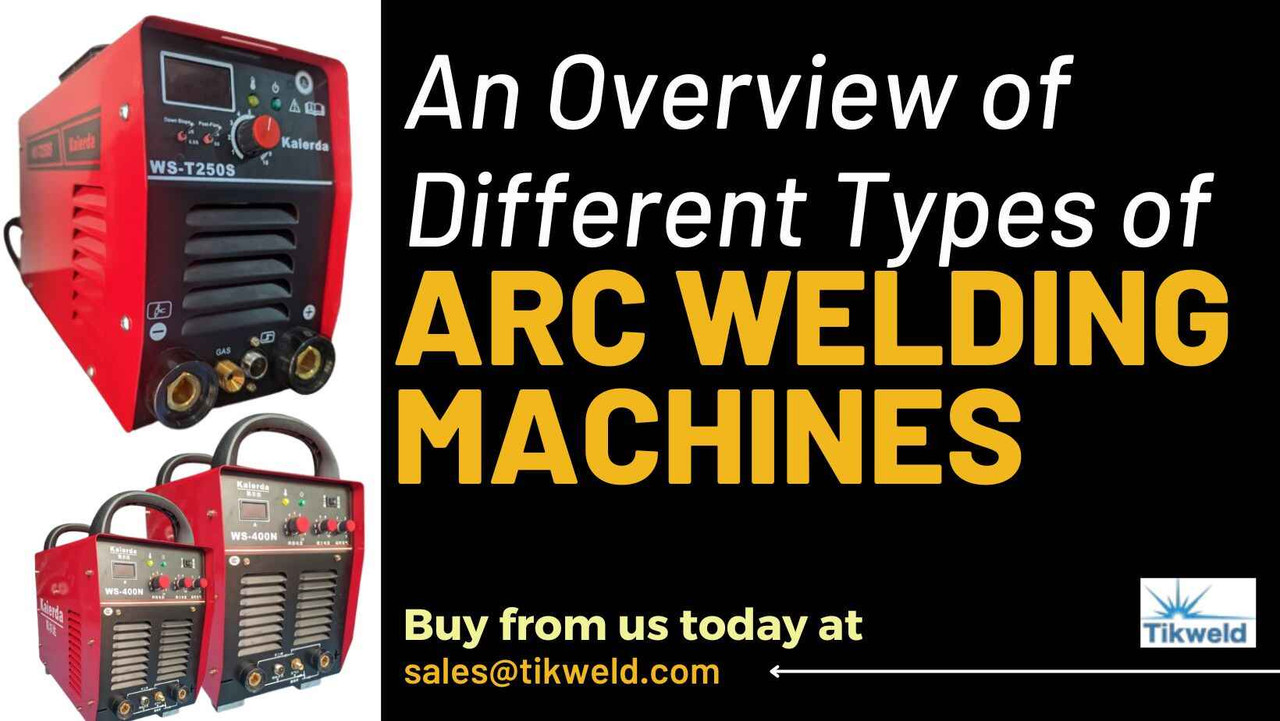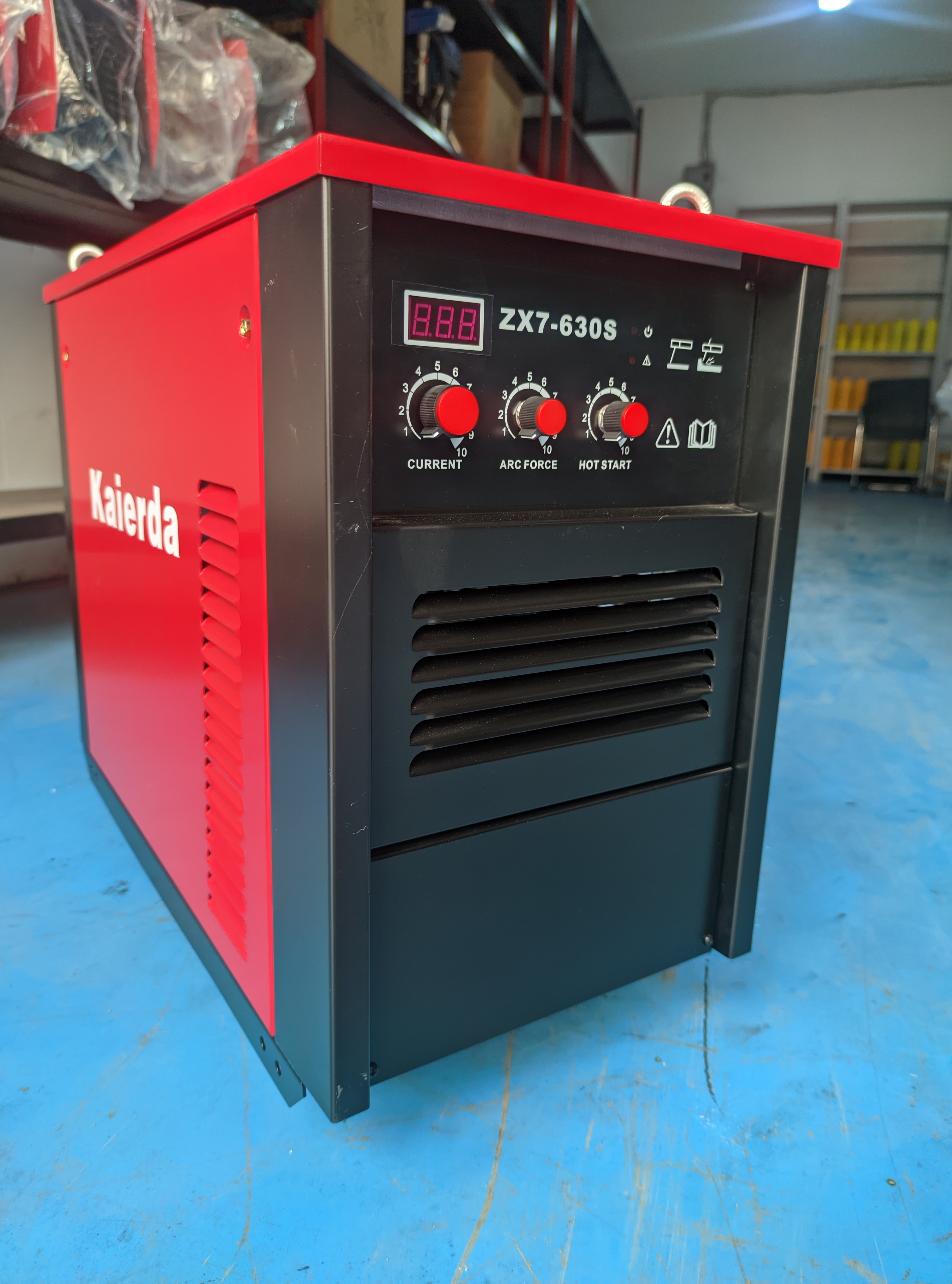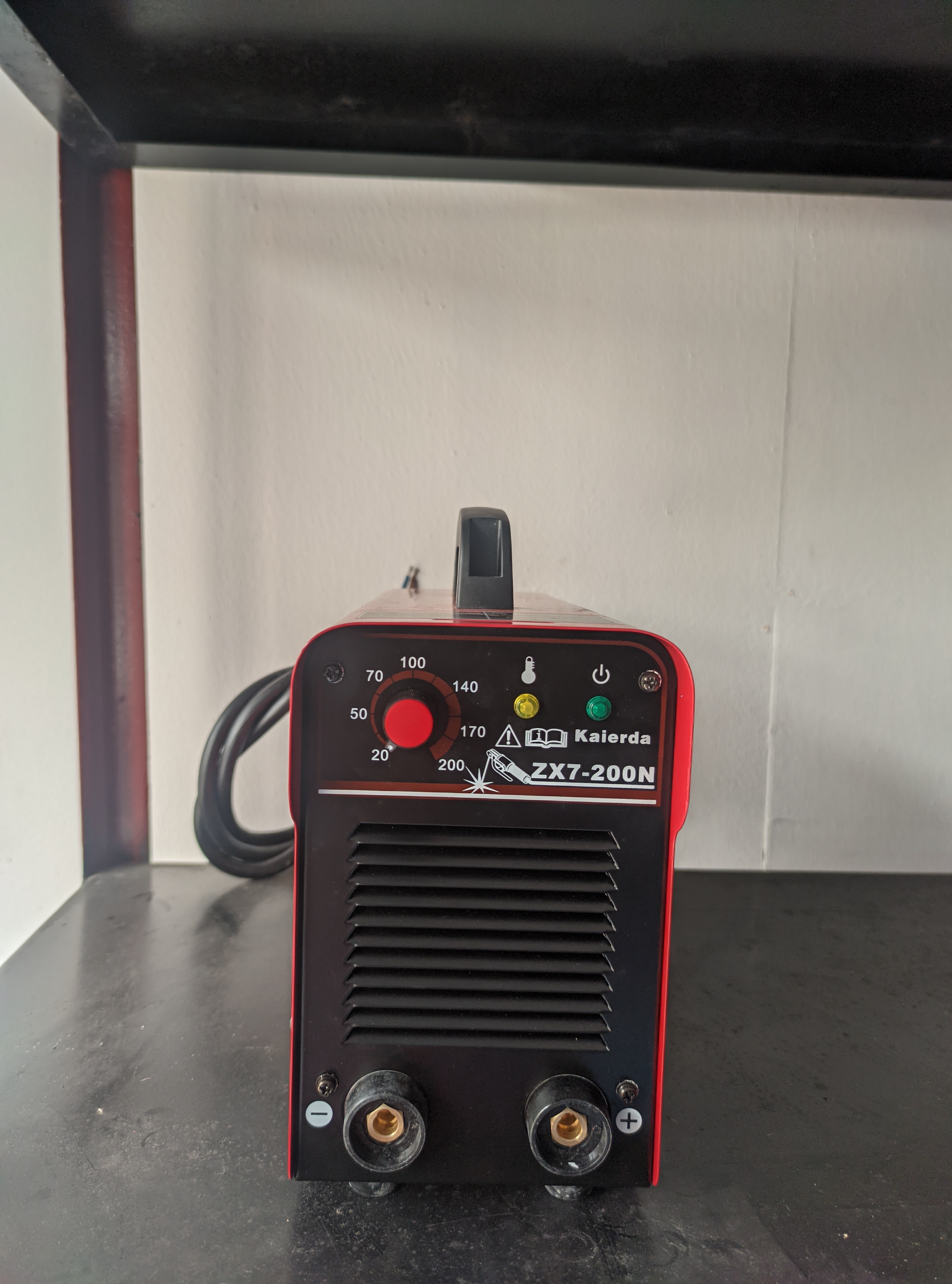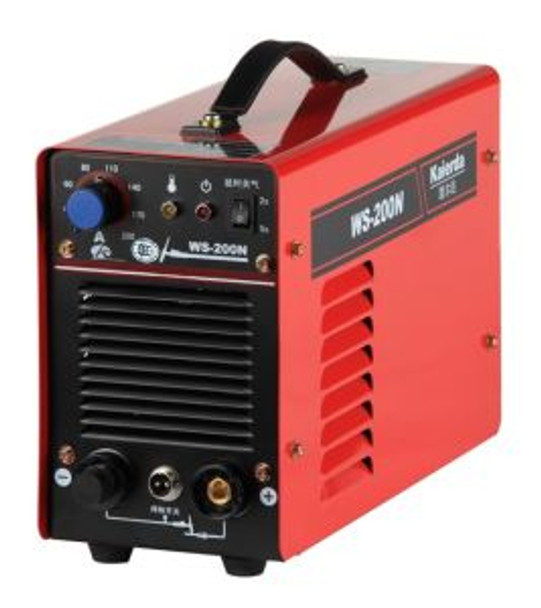An Overview of Different Types of Arc Welding Machines
Introduction
Arc welding machines are foundational tools in the world of welding and metalworking. These versatile machines play a pivotal role in joining metals, a process crucial in numerous industries and applications. Whether in construction, automotive manufacturing, shipbuilding, or DIY projects, arc welding machines are indispensable for creating strong, durable bonds between metals.
The significance of arc welding machines lies in their ability to generate intense heat through an electric arc, melting the edges of metal workpieces and fusing them together. This process allows for the creation of robust and reliable connections that can withstand the test of time. Whether it's constructing a skyscraper's steel framework, fabricating intricate metal sculptures, or repairing essential components of vehicles and machinery, arc welding machines are the go-to choice for professionals and enthusiasts alike.
Arc welding machines offer exceptional flexibility, enabling welders to work with a wide range of metals and alloys, from mild steel and stainless steel to aluminum and exotic materials like titanium and Inconel. The welder's skill, combined with the precise control afforded by these machines, ensures the integrity and quality of welded joints. Without arc welding machines, many of the structures and products that define our modern world would simply not exist.
Read more...The Ultimate Guide to Arc Welding Machines: Types, Features, and Applications
Kaierda inverter manual arc welding machine ZX7-630S
Key Takeaway
- Arc welding machines use an electric arc to melt metals and create strong joints, making them essential in construction, fabrication, and manufacturing.
- There are various types of arc welding machines, including Stick (SMAW), MIG (GMAW), TIG (GTAW), and Flux-Cored (FCAW), each designed for different materials and applications.
- Stick welding machines are versatile, cost-effective, and ideal for outdoor work and heavy-duty tasks.
- MIG welding machines are user-friendly, high-speed, and perfect for beginners and large-scale production with clean, smooth welds.
Overview of the Main Types of Arc Welding Machines
In this comprehensive exploration, we will delve into the diverse world of arc welding machines, each designed to excel in specific welding applications. These machines are not one-size-fits-all; instead, they offer unique capabilities, advantages, and limitations. Our journey will introduce you to the following main types of arc welding machines:
- Shielded Metal Arc Welding (SMAW) Machines: Often referred to as "Stick" welding, SMAW machines are known for their simplicity, durability, and adaptability. They are widely used in construction, maintenance, and repair work.
- Gas Metal Arc Welding (GMAW or MIG) Machines: Commonly known as "MIG" welding, these machines excel in speed and efficiency, making them popular for automotive, fabrication, and general welding applications.
- Gas Tungsten Arc Welding (GTAW or TIG) Machines: Renowned for precision and cleanliness, TIG welding machines are favored in industries where the utmost control and weld quality are essential, such as aerospace and artistic welding.
- Submerged Arc Welding (SAW) Machines: SAW machines are heavy-duty workhorses, often used in industrial applications like shipbuilding, pipeline construction, and the manufacturing of large structural components.
As we progress through this exploration, you will gain a deeper understanding of each type of arc welding machine, its unique characteristics, applications, and the factors to consider when selecting the right arc welding machine for your welding needs. Whether you are a seasoned welder seeking to expand your expertise or a novice eager to embark on a welding journey, this guide will equip you with the knowledge to make informed decisions and achieve exceptional results in the world of arc welding.
Kaierda Inverter/Arc Welding machine ZX7-200N/220V/DC
Types of arc welding machines
In this comprehensive exploration, we will delve into the diverse world of arc welding machines, each designed to excel in specific welding applications. These machines are not one-size-fits-all; instead, they offer unique capabilities, advantages, and limitations. Our journey will introduce you to the following main types of arc welding machines:
Shielded Metal Arc Welding (SMAW) Machines:
Often referred to as "Stick" welding, SMAW machines are known for their simplicity, durability, and adaptability. They are widely used in construction, maintenance, and repair work. However, Shielded metal arc welding (SMAW) is a fusion welding process that uses a consumable, flux-coated electrode to create an arc between the electrode and the work piece. Molten metal travels from the electrode via the electrical arc and is deposited into the workpiece.
Gas Metal Arc Welding (GMAW or MIG) Machines:
Commonly known as "MIG" welding, these machines excel in speed and efficiency, making them popular for automotive, fabrication, and general welding applications. In this process, an arc is struck between the base metal and a continuously supplied consumable electrode, which provides filler metal for the weld.
Gas Tungsten Arc Welding (GTAW or TIG) Machines:
Renowned for precision and cleanliness, TIG welding machines are favoured in industries where the utmost control and weld quality are essential, such as aerospace and artistic welding. Gas tungsten arc welding (GTAW), also known as tungsten inert gas (TIG) welding, is an arc welding process that uses a non-consumable tungsten electrode to produce the weld. The weld area and electrode are protected from oxidation or other atmospheric contamination by an inert shielding gas (argon or helium).
Submerged Arc Welding (SAW) Machines:
SAW machines are heavy-duty workhorses, often used in industrial applications like shipbuilding, pipeline construction, and the manufacturing of large structural components. Submerged Arc Welding (SAW) is a joining process that involves the formation of an electric arc between a continuously fed electrode and the workpiece to be welded. A blanket of powdered flux surrounds and covers the arc and, when molten, provides electrical conduction between the metal to be joined and the electrode. The Submerged welding process is used for welding of low alloy steels. It is also used for stainless steels and nickel based alloys. SAW can also be used for surfacing applications such as wear-facing, corrosion overlay of steels, etc.
Read more...Welding Machine Types Explained: Choosing the Right One for Your Project
Pros and Cons of arc welding

Despite the enormous advantages a lot of measures must be put in place for the overall safety of the welder when involved in arc welding. The following are Essential Safety practices of arc welding.
YAWATA 7018 Arc Welding Electrode
Essential Safety Practices in Arc Welding Every Welder Should Know
Arc welding, the process of joining metals by melting them with an electric arc, is a skill that combines artistry with craftsmanship. In the hands of a skilled welder, metal is transformed, creating everything from towering skyscrapers to intricate sculptures. Yet, within this mesmerising dance of sparks and molten metal lies a crucial factor: safety.
Welding, by its very nature, presents a spectrum of potential hazards. From intense heat to high-voltage electricity and hazardous materials, welders work in an environment where the slightest lapse in safety can result in serious consequences.
Welding safety is not an optional aspect of the craft but an essential part of every welder's responsibility. The importance of welding safety cannot be overstated, and it encompasses a multitude of facets, including:
- Protecting Lives: The foremost purpose of welding safety is the preservation of human life. In welding, dangers lurk in the form of electric shocks, welding fumes, burns, and fires. Adequate safety measures and equipment act as the armour shielding welders from harm.
- Health and Well-being: Beyond immediate safety, welding safety is about safeguarding the long-term health of welders. Prolonged exposure to welding fumes, for instance, can lead to respiratory illnesses. Prioritising safety is an investment in one's health and longevity.
- Quality and Efficiency: Safety is not an impediment but an enabler of productivity and quality. A safe workspace minimises disruptions caused by accidents, allowing welders to concentrate on their craft. Well-maintained equipment ensures consistent, high-quality welds.
- Legal and Ethical Obligations: Compliance with safety regulations is not just a legal requirement but also an ethical responsibility. Ensuring one's safety and that of fellow workers is a testament to professionalism and integrity.
Personal Protective Equipment (PPE) includes
- Head protection: Helmets and headgear
- Eye protection: Welding goggles and face shields
- Respiratory protection: Welding respirators and ventilation
- Body protection: Welding jackets, aprons, and gloves
- Foot protection: Welding boots and shoe covers
Welding Environment Safety includes:
- Proper workspace setup and organisation
- Fire prevention and control measures
- Adequate lighting and visibility
- Safe storage of welding equipment and materials
- Identification of emergency exits and fire extinguishers
Electrical Safety include
- Grounding and electrical circuit safety
- Handling electrical cords and plugs
- Inspecting welding machines for electrical safety
- Protection against electrical shocks
KAIERDA ARGON WELDING MACHINE WS-200 ARC/TIG
Welding Fume Extraction and Ventilation
- Risks associated with welding fumes
- The importance of adequate ventilation
- Using welding fume extractors and hoods
- Monitoring air quality in the welding area
Safe Handling of Welding Electrodes and Consumables
- Proper storage of welding electrodes
- Handling electrodes to prevent contamination
- Recognizing damaged or defective electrodes
- Ensuring the correct storage temperature
Fire Safety and Fire Extinguisher Use
- Types of fires in welding environments
- Selecting the right fire extinguisher for each fire class
- Correct usage of fire extinguishers
- Emergency response in case of a fire
Safe Work Practices
- Positioning and posture during welding
- Preventing slips, trips, and falls
- Avoiding welding fatigue and discomfort
- Maintaining focus and concentration
- Welding Equipment Inspection and Maintenance
Readers Also Watched...
How to choose the right arc welding machines
Welding machines are the backbone of buildings, metal working industries providing strength, stability, and durability. There are several types of welding machines but the use of arc welding machines in the welding industry is the most versatile because of their paramount importance in the construction of project works. The Selection of appropriate arc welding machines directly impacts the overall outcome of the project because it influences the safety, longevity, and cost-effectiveness of welding processes.
Power Source and Output
Determining the Appropriate Amperage Range:
Selecting the right amperage range is a crucial consideration in choosing an arc welding machine. Amperage determines the heat intensity of the arc, directly impacting the penetration and quality of the weld. For thinner materials, lower amperage is suitable to prevent burn-through, while thicker materials require higher amperage for proper fusion. The machine you choose should offer an amperage range that covers the spectrum of your welding tasks.
AC vs. DC Welding Machines:
Arc welding machines operate on either alternating current (AC) or direct current (DC). Understanding the differences between AC and DC welding is vital. DC welding provides consistent and stable arcs, making it suitable for most applications. AC welding, on the other hand, is often preferred for welding aluminium due to its ability to prevent oxide formation. Consider the materials you'll be welding and the advantages of each current type when making your choice.
Duty Cycle
Duty cycle represents the amount of time a welding machine can operate at a given amperage within a specific time frame before needing to cool down. For example, a machine with a 60% duty cycle at 200 amps can weld continuously for 6 minutes out of every 10 minutes. A higher duty cycle indicates better thermal management and longer welding periods without interruptions. When selecting a machine, match the duty cycle to the demands of your projects. Heavy-duty applications necessitate higher duty cycles to prevent overheating and downtime.
Welding Voltage and Control
Welding voltage plays a significant role in controlling the characteristics of the weld. Voltage settings affect the arc length, penetration depth, and overall weld quality. Having the ability to adjust voltage is essential for fine-tuning the welding process according to the materials and joint configurations. Look for a machine that provides voltage control, as well as presets for common welding scenarios, allowing you to achieve consistent results.
Portability and Size
The portability and size of the welding machine can influence its usability in various environments. Consider the mobility requirements of your projects. If you'll be moving the machine between job sites or working in confined spaces, opt for a compact and lightweight design. Machines equipped with handles, wheels, or carrying options make transportation easier, enhancing your flexibility and efficiency.
User-Friendly Interface and Controls
A user-friendly interface contributes to efficient and effective welding operations. Clear controls, labelled settings, and intuitive displays make setup and adjustments easier, especially for those new to welding. Machines with ergonomic designs and well-organised control panels simplify the process of fine-tuning welding parameters. Digital displays provide real-time feedback, enhancing your ability to monitor and adjust settings for optimal results.
Advanced Features
Modern arc welding machines often offer advanced features that elevate your welding capabilities:
- Pulse Welding: Pulse welding modulates the welding current, allowing you to control heat input. This is especially beneficial for thin materials and preventing distortion.
- Adjustable Arc Force: Arc force adjustment maintains arc stability, even at low amperages or in challenging positions. This feature minimises spatter and electrode sticking.
- Hot Start and Arc Force: Hot start provides an initial higher amperage to facilitate easy arc initiation, while adjustable arc force maintains the arc's stability during welding.
These advanced features provide you with enhanced control and versatility in achieving specific welding outcomes. However, their necessity depends on the complexity of your projects and your skill level.
Frequently asked questions
1. Why do we prefer arc welding?
High welding speed – Arc welding is a fast welding process, making it suitable for high production rates and large-scale projects. Versatility – Arc welding can be used on a wide range of materials, including steel, aluminium, and cast iron, making it a versatile method for welding different materials.
2. Is arc welding better than gas welding?
Gas welding is ideal for non-ferrous metals, whereas arc welding supports both ferrous and non-ferrous metals. Most professional welders will agree that gas welding is more difficult than arc welding. It requires greater precision due to its gas-based fuel. Arc welding, in comparison, is easier.
3. What is required for arc welding?
For the arc welding, the temperature of the arc should be 3500° C. At this temperature, mechanical pressure for melting is not required. Both AC and DC can be used in arc welding. Arc welding usually requires high current (over 80 amperes) and it may need around 12000 amperes in spot welding.
4. What is the risk of arc welding?
Health hazards from welding, cutting, and brazing operations include exposures to metal fumes and to ultraviolet (UV) radiation. Safety hazards from these operations include burns, eye damage, electrical shock, cuts, and crushed toes and fingers.
5. What gas is used in arc welding?
Argon is used in arc welding as it shows low reactivity with metals. During welding, there is no chemical change. But at high temperatures, the metals react with atmospheric oxygen to form oxides. As argon is an unreactive inert gas thus there is no reaction between argon and the welded metal.
Related Articles
A comprehensive guide to Shielded Metal Arc Welding Machines
Buy Used Welding Machines and Equipment in Nigeria
Argon Gas Welding: Creating Strong and Durable Welds
Conclusion
No matter the project—heavy-duty fabrication or detailed precision work—there’s an arc welding machine built for the task. Knowing the differences between MIG, TIG, Stick, and Flux-Cored machines puts you in control of cleaner welds, better efficiency, and stronger results.
Looking to level up your welding setup?Browse our selection of premium arc welding machines now at Tikweld. Let your next weld speak strength, precision, and quality.











